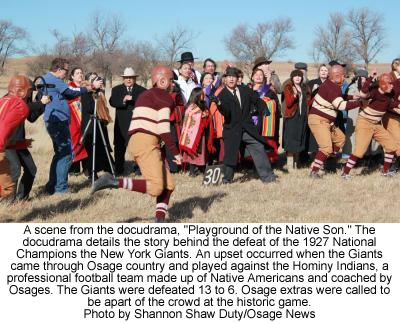 |
Canku Ota
|
 |
|
(Many Paths)
|
||
|
An Online Newsletter
Celebrating Native America
|
||
|
May 2013 - Volume 11
Number 5
|
||
|
|
||
|
Filming Complete
for Docudrama on Hominy Indians Team
|
||
|
by Shannon Shaw Duty
- Osage News
|
||
|
Film's producer hopes to have it ready for a June release
"We should have it finished in six months," Xavier said at the Osage Nation Foundation Christmas Celebration Dec. 15, where cast and crew were invited. Director of the docudrama, Michael Nash, heard Xavier's comment and said jokingly, "Eight months." Xavier said that when the film is finished she plans on having a showing in Pawhuska for Osages and area Natives. Xavier also wrote the Osage Tribal Murders documentary about the Osage Reign of Terror. Nash directed the 2010 documentary Climate Refugees, a film investigating mass migrations caused by the changing climate, according to the IMDb.com Web site. According to the documentary Web site, the docudrama is based on the 1920s all-Native Hominy Indians professional football team and their 28-game winning streak. The 1925 Hominy Indians professional football team represented 14 different tribes from 1925-1936. The brainchild of Ira Hamilton, Osage, the Hominy Indians was a group of young Native athletes from all over Indian Country. Mostly made up of players that played for the Haskell Institute, now known as Haskell Indian Nation's University in Lawrence, Kans., the team's home base was in Hominy. Many Osages played on the team, which was formed in 1923. The Indians shot to fame after never being beaten--or tied with--even though they had played in football games all over the country, especially the East Coast, according to an article by Arthur Shoemaker in 1992. The National Football Champions that year, the New York Giants, traveled to Pawhuska the day after Christmas to play the famous Indians, three weeks after winning their national title against the New York Rangers. After a grueling game in front of reportedly 2,000 fans, and being down at the half, the Hominy Indians beat the Giants 13-6. Urban legends still abound on the Osage reservation about the Hominy Indians team. Eyewitness accounts passed from one Osage to another that said player John Levi could dropkick the football, which was round and heavier than today's football, from the 50-yard line through the goal posts back and forth and pass the ball 100 yards. Another player, Johnnie "Pepper" Martin, went on to play baseball for the St. Louis Cardinals, and it's rumored that Jim Thorpe, voted one of the best athletes in American history, played on the team for a couple of years. The documentary film project was initially called Blood Battle in July of 2012 when it was awarded a $25,000 Osage Nation Foundation arts matching grant before being renamed Playground of the Native Son. To make donations for the film, contact the Osage Nation Foundation at (817) 421-5620. For mail in donations: Please make checks payable to "Osage Nation Foundation." Donation for the HIF Documentary, P.O. Box 92777, Southlake, TX 76092. The Osage Nation Foundation is a non-profit organization that exists to promote the continued development of the Osage Reservation and the communities influenced by the Osage Nation. All contributions are tax deductible.
Hominy Indians Memorial At a 2009 opening for a Hominy Indians exhibit at the Wah Zha Zhi Cultural Center, many descendants of the football team attended. Ira Hamilton's descendants brought their families, as well as George Kipp's descendants. Kipp was a full-blooded Blackfeet Indian from Browning, Mont. The late Virginia Maker, mother to Osage Congressman John Maker and daughter of Hominy Indians player Arlen "Buck" Harding, said that her mother and father met while he was on the team and her mother always looked forward to watching her father play. She said that they had her father's Indians uniform for a long time but have since lost it. Maker was excited by the news of a possible Hominy Indians memorial at the time. She said that she would love to see a memorial built to the team, but she wanted it to be built in Hominy. Vann Bighorse, director of the Wah-Zha-Zhi Cultural Center said the cultural center is working on a historical marker to be placed in the Hominy Indian Village that tells the history of the team. Plans are still in the works and he plans to present his plan to the Third Osage Nation Congress for funding and approval. He hopes to be finished with the historical marker in 2013. To see more photos from the set of Playground of the Native Son, visit the Osage News Flickr page at www.flickr.com/photos/osagenews/. |
|
|
||
|
|
||
| Canku Ota is a free Newsletter celebrating Native America, its traditions and accomplishments . We do not provide subscriber or visitor names to anyone. Some articles presented in Canku Ota may contain copyright material. We have received appropriate permissions for republishing any articles. Material appearing here is distributed without profit or monetary gain to those who have expressed an interest. This is in accordance with Title 17 U.S.C. Section 107. | ||
|
Canku Ota is a copyright ©
2000 - 2013 of Vicki Williams Barry and Paul Barry.
|
||
 |
 |
|
|
The "Canku
Ota - A Newsletter Celebrating Native America" web site and
its design is the
|
||
|
Copyright ©
1999 - 2013 of Paul C. Barry.
|
||
|
All Rights Reserved.
|
||
 The
filming for the docudrama Playground of the Native Son has
wrapped and producer Celia Xavier hopes to have the documentary
finished by June of 2013.
The
filming for the docudrama Playground of the Native Son has
wrapped and producer Celia Xavier hopes to have the documentary
finished by June of 2013. 